Including Edinburgh Associated Thinkers
Liam P. McLaughlin (2022) “Including Edinburgh associated thinkers: supporting the inclusion of Edinburgh associated thinkers within Edinburgh University’s undergraduate Politics courses”
Notes on this edition
This article is an extract of a larger work for the 2022 Summer sitting of the SLICC course. In this extract a discussion of the current approach to teaching Hume and Smith is provided and brief introductions to the works of Thomas Muir, Marion Kirkland Reid, James Connolly and Julius Nyerere are given. The aim of this project is to support current academics to broaden their undergraduate Politics courses to include thinkers that have some association with the University. The justification for this aim is given in the introduction but can be summarized as: “being part of the University should have some meaning as a learning community. One part of that is to show undergraduate students that a tradition of world-leading academia has taken place here, continues to take place here, and that present students can take part in that rich tradition too. A start is to acknowledge that such a tradition exists”. Due to the shortening of this extract sections on John Muir, Fredrick Douglas and John MacLean have been removed – various sections of text have also been shortened or edited. Those sections and thinkers can be made available on request.

Left to right: Thomas Muir, Marion Kirkland Reid, James Connolly, Julius Nyerere.
Extract of “Supporting the inclusion of Edinburgh associated thinkers within undergraduate Politics Courses – by Liam McLaughlin”
Completed for The University of Edinburgh during a Student-Led Individually-Created Course (SLICC) June – August 2022
Abstract
In contrast to the University’s other humanities programs, there is a lack of Edinburgh related/associated thinkers being studied within undergraduate politics courses. More broadly within the humanities when Edinburgh thinkers are discussed they are often restricted to the study of Hume and Smith. To support existing lecturers in potentially broadening scope of their courses, I aim to gather resources and provide a tour of the literature surrounding some interesting and often neglected Edinburgh-associated thinkers. Additionally, a brief investigation of best practice from courses outside of Political Science is considered to suggest strategies to make studying these local thinkers as engaging as possible.
Acknowledgements
This project was completed as part of a summer Student-Led, Individually-Created Course (SLICC) offered by the University for students to gain Level-8 credits for work done on an independent project or a volunteer work experience. The program assesses students’ ability to reflect on their chosen project and show development in their skill sets and approach to learning over a 6-week period. I would like to thank Dr Mihaela Mihai for helping me design and clarify the scope of this project as well as suggesting research methods; the National Museum and Libraries of Scotland for providing access to first hand material on various thinkers; and the SLICC course team for providing an output for this project and reflective tools that helped organise my thoughts.
Introduction
The required modules for the first two years of an Edinburgh University MA (Hons) with Politics [1] are “Introduction to Politics and International relations (PLIT08004)”, “Political Thinkers (PLIT08011)”, and “International Cooperation in Europe and Beyond (PLIT08006)”. However, none of these courses currently studies any thinkers that are associated with Edinburgh university, let alone any wider thinkers from Scotland. On this front, Politics seems to be an outlier within the Edinburgh’s humanities courses, that for the most part make frequent reference to Edinburgh-associated thinkers. For example, the School of Philosophy, Psychology, and Language Science, dedicates substantial parts of their courses to both Enlightenment and current Edinburgh thinkers[2]. In the school of Economics, though in general no effort is made to study any particular thinker, thinkers who studied or lived in Edinburgh are frequently name-dropped at relevant points in the course (Adam Smith, Maclaurin, and Bayes). Moreover, it will not be lost on anyone who has visited an Oxford or Cambridge college dining hall that the walls flaunt past academics and are impressed upon students at every mealtime. I think that in all these courses past thinkers are used to create a communal tradition and expectation of excellence that helps to orient students as they begin their study. On a wider note, surely if any university is best placed and has the resources to deliver the most insightful teaching on a thinker that grew up in, studied at, or worked in Edinburgh and keep the memory of that thinker alive, it is the University of Edinburgh. This begs the question “Why is it that there are no Edinburgh based political thinkers studied in Edinburgh undergraduate politics courses?”
From what I have gathered in discussions with staff, this is due to a combination of a lack of experience in studying Edinburgh-associated thinkers within the department and a commitment to maintaining an internationalized curriculum. However, as I hope to demonstrate, neither of these preclude the inclusion of Edinburgh-associated thinkers. This project aims to address both these concerns by identifying thinkers that fit into the current department preferences (talked about below) and provide a brief survey of the works of, and the works surrounding, selected authors. It is not intended to be a comprehensive list or an in-depth study but enough that a lecturer can determine if a particular thinker would be a good fit for their course and where to begin looking for resources. Additionally, a brief survey of other university courses is included at the end of this project to find precedent on how to make the inclusion of local thinkers most effective.
The primary influence on the scope of this project is Professor George Davie’s book (1961) “The Democratic Intellect” in which he analyses the state of Scotland’s Universities from the pre-enlightenment era onwards. Davie documents what he sees as the loss of the interdisciplinary and ‘democratic’ nature of Scottish education, a tradition that he argues originated from Scotland’s lower financial thresholds for entry and comparatively less hierarchical academic structure. This project aims to reunite with this ‘democratic’ tradition by identifying figures that were from an interdisciplinary background and educated within Edinburgh/Scotland’s ‘democratic’ framework. Importantly, Davie attributes the cause of decline of the ‘democratic’ intellect to the homogenisation of tertiary education across the British Isles. Therefore, diversification by finding relatively obscure thinkers that are not often studied by other courses, such as Marion Kirkland Reid or John MacLean, has been prioritised.
Additionally, though the university places great emphasis on widening access to deprived and first university generation Scottish students (through programs like Edinburgh LEAPS) these students often feel uneasy about their inclusion, often experiencing a feeling that they are not truly part of a largely southern county student population – reinforcing Imposter Syndrome. An example is the quite exclusionary middle-class undertones in articles and student commentary that followed the reports that the newest intake of Scottish law students would be almost exclusively from disadvantaged backgrounds (Times 2022 & Scottish Legal Times 2022). Upon this there is an additional tension that the lower Scotland fee-rate limits the number of Scottish students admitted to the high per-student cost Universities in favour of an international/r-UK fee-paying students. Edinburgh being the premier Scottish university and the most internationally renowned, amplifies these effects, leading to acceptance rates at UoE being consistently lower for Scots than their international or r-UK counterparts[3]. This leads to a certain students, often from the most vulnerable backgrounds that have had the greatest financial and social barriers from entering Edinburgh University, feeling unrepresented and not catered to by the institution.
Internationalisation is a good and the bedrock of a tradition, in this country, that spans back to the medieval Peregrinatio Academica. But, the way we quantify internationalisation is fundamentally adversarial. The QS University Rankings (which the University routinely flaunts its 15th place) bases one part of its measurements on “internationalisation” which they measure as the proportion of international students to domestic students (and is one of the university’s strongest scores). This way of measuring internationalization directly creates a trade-off between the domestic student population the international and therefore pits them such that any university with financial sense should attract high fee-paying students by the increase of international students and rejection of domestic students. Of course this is a self-reinforcing process as Universities that have a high proportion of international students will place highly on University rankings and, therefore, will attract an again higher proportion of international students, further boosting the University’s score, so on and so forth. This misunderstanding of internationalisation as an adversarial process appears transferred to teaching and leads to the situation we see in the department where courses do not try to include Edinburgh based thinkers under the view that including even thinkers from Scotland would directly undermine their commitment to internationalisation. If this remains, we have an international curriculum that studies everywhere but Edinburgh and provides no role models to marginalized students who find themselves rarely represented in the thinkers that courses choose to study. Understanding that internationalization of the curriculum should be about how we study thinkers[4] rather than, as the QS method would suggest, being about who studies them is an important steppingstone in reversing this trend.
Instead of the discussed adversarial internationalization, in this project a great emphasis has been put into choosing figures that are potentially internationally significant or have corresponded with an international group of thinkers. The reason for this is that while introspection into the University’s past thinkers may be good to provide a course’s “self-image” when it is done in isolation of the larger academic context it can become self-referential and narrow. To this end, thinkers that had interests in more contemporarily active fields of study, like Julius Nyerere’s Pan-Africanism or John Muir’s Naturalist Environmentalism, were considered to fit within the department’s current interests. Further to the discussed goal of widening access, an effort has been made to find figures that a range of students can identify with across gender, race, and social class backgrounds. An effort must also be made to contextualise and discuss the unpleasant truth that the wealth and prominence of the city of Edinburgh, and thus the University, were built upon slavery and Empire. Accordingly, we must do a better job in communicating uncomfortable aspects of prominent Edinburgh associated thinkers that have served to perpetuate this historic dynamic, namely Hume and Smith.
Finally, the motivation for this project is not nationalistic or identitarian but a view that, particularly following the disconnected period of distance learning, being part of the University should have some meaning as a learning community. One part of that is to show undergraduate students that a tradition of world-leading academia has taken place here, continues to take place here, and that present students can take part in that rich tradition too. A start is to acknowledge that such a tradition exists.
Discussing Hume and Smith

When discussing Edinburgh’s thinkers, it is hard to escape the two seminal names of the Scottish enlightenment, David Hume, and Adam Smith. Their reputation is undoubtedly deserved; Smith being the author of The Wealth of Nations and widely regarded as the father of modern economics, while Hume’s influence spread from Philosophy, Theology, History, Political and Cognitive Science such that he is regarded as a principal figure and still has aspects of many fields of study named after him. In recent years, however, there has been a re-examination of the two thinkers leading to well considered but increasingly public spats between academics within the university over Hume’s place in the University. In response to student pressure, the David Hume Tower was renamed to 40 George Square in 2021.
Despite this pressure campaign, within the student population there is a remarkably low degree of understanding (even from those studying Philosophy and Theology) of the reasons why the Hume tower was renamed beyond a vague notion of that he was racist. Moreover, there has been little acknowledgement within the teaching I have received, more than at a superficial level, of the problematic nature of these thinkers. Hume and Smith were both politically active and through social clubs intricately involved in the intellectual class of north-Britons that at the time tacitly perpetuated slavery and Empire across the world, and the conservative suppression of democratic dissent at home (In Our Time 2015). Yet, despite the unpleasantness contained (particularly) within parts of Hume’s writing, there are very few departments in the University’s teaching that will not be in some way have been influenced by these thinkers. Therefore, rather than the purging of Hume and/or Smith from the curricula, or to disregard any of their wrongdoing, it is important that as an institution, who in the eyes of many are historically tied to these thinkers, we should contextualize the unpleasant aspects that were, desormais, part of their respective philosophies.
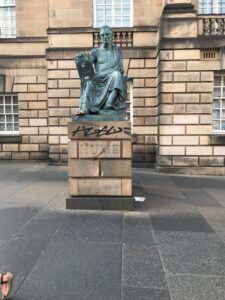
Though there are quite a few instances where Hume’s writing have been problematic the most potent example can be seen in Hume’s ‘Of national characters’ 1753. Where he writes “I am apt to suspect the negroes and in general all other species of men (for there are four or five different kinds) to be naturally inferior to the whites. There never was a civilised nation of any other complexion than white, not even any individual eminent either in action or speculation. No ingenious manufactures amongst them, no arts, no sciences … In Jamaica, indeed, they talk of one Negroe as a man of parts and learning; but ‘tis likely he is admired for very slender accomplishments, like a parrot, who speaks a few words plainly”. The traditional view advocated for by Popkin (1977) in an article called “Hume’s Racism” is that Hume’s racist views were a ‘casual aberration’, racist but not all consuming so that it tarnished his other work. This seems at first quite plausible. Hume was often purposely controversial and held what sometimes seemed deliberately contrarian positions. In the same decade as the publishing of ‘Of National Characters’ and the uptick of his literary career, Hume found himself censored by the Index Librorum Prohibitorum for his controversial atheism. Hume held these positions publicly to the point that after his death his grave was attacked by religious zealots (necessitating the fortifications seen around his tomb above). However, as argued by Immerwahr (1992), Hume’s racism spread beyond just a need for controversy and should be examined deeper. Hume had direct participation in the British diplomatic service as Paris based aide to the secretary of state, involving himself in the running of the British empire, and both facilitated by correspondence and encouraged his friends to invest in West African slave plantations. Immerwahr’s analysis goes much deeper than this and is a must-read for those discussing Hume. There is also an interesting contrast between Hume and his philosophical ‘rival’ Dr James Beattie, who in contrast to Hume was repulsed by slavery due to his religious sensibilities. Studying this would be interesting for a Philosophy course by comparing the epistemic views of Beattie and Hume. Additionally, the National Portrait gallery of Scotland does very well to provide a concise summary of Hume’s more contentious views beside his portrait in the galleries on Queen St, Edinburgh.
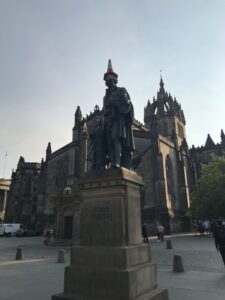 Smith has been more fortunate than Hume in escaping a rightful reckoning on his positions. This is most likely due to Smith’s name being still useful as a namesake to various current organisations, that in turn defend his legacy. For example, in response to a leaked memorandum from Sir Geoff Palmer’s Edinburgh Slavery and Colonialism Legacy Review Group, that had placed Smith’s name on a list of monuments tied to slavery, the right-wing think tank, The Adam Smith Institute, produced a document arguing that in context of his time Smith was a “fierce critic” of slavery and that his “argument was used as fuel to stoke the blazing fire of the abolitionist movement”(Adam Smith Institute 2021). However, under close examination this does not hold up. Though it is true that Smith did argue against slavery, his concern did not stretch to moral or religious grounds. Smith simply stated that it would be more profitable to end the practice of slavery in favour of low wage subsistence labour. Indeed, Smith seemed to favour that slave plantations move from chattel slavery to the indentured servitude that characterized Scottish Colliers and Salters, who though legally citizens with rights were born into a hereditary binding contract system that forced them to work for little pay and in often conditions on par with chattel slavery. It can be argued, as does the Adam Smith institute, that Smith was merely providing a more tactful argument for abolition. However, when we consider that Smith was a pessimist about slavery being anything other than man’s natural condition, we may see that Smith was not such a radical as suggested. He even argued that to “set a slave at liberty this was robbing his master of the whole value of him. This therefore could never take place. This institution therefore of slavery, which has taken place in the beginning of every society, has hardly any possibility of being abolished” (A. Smith, R. L. Meek. 1793). A very insightful article by Jack Russell Weinstein(2017) goes into much more depth and surrounds the context of smith’s slavery positions. Relatedly, for a truly fierce critique of slavery from Scottish thinkers it would be better to look at James Beattie (Aberdeen and a critic of Hume), Thomas Muir (Edinburgh), or William Dickson (Stonehaven).
Smith has been more fortunate than Hume in escaping a rightful reckoning on his positions. This is most likely due to Smith’s name being still useful as a namesake to various current organisations, that in turn defend his legacy. For example, in response to a leaked memorandum from Sir Geoff Palmer’s Edinburgh Slavery and Colonialism Legacy Review Group, that had placed Smith’s name on a list of monuments tied to slavery, the right-wing think tank, The Adam Smith Institute, produced a document arguing that in context of his time Smith was a “fierce critic” of slavery and that his “argument was used as fuel to stoke the blazing fire of the abolitionist movement”(Adam Smith Institute 2021). However, under close examination this does not hold up. Though it is true that Smith did argue against slavery, his concern did not stretch to moral or religious grounds. Smith simply stated that it would be more profitable to end the practice of slavery in favour of low wage subsistence labour. Indeed, Smith seemed to favour that slave plantations move from chattel slavery to the indentured servitude that characterized Scottish Colliers and Salters, who though legally citizens with rights were born into a hereditary binding contract system that forced them to work for little pay and in often conditions on par with chattel slavery. It can be argued, as does the Adam Smith institute, that Smith was merely providing a more tactful argument for abolition. However, when we consider that Smith was a pessimist about slavery being anything other than man’s natural condition, we may see that Smith was not such a radical as suggested. He even argued that to “set a slave at liberty this was robbing his master of the whole value of him. This therefore could never take place. This institution therefore of slavery, which has taken place in the beginning of every society, has hardly any possibility of being abolished” (A. Smith, R. L. Meek. 1793). A very insightful article by Jack Russell Weinstein(2017) goes into much more depth and surrounds the context of smith’s slavery positions. Relatedly, for a truly fierce critique of slavery from Scottish thinkers it would be better to look at James Beattie (Aberdeen and a critic of Hume), Thomas Muir (Edinburgh), or William Dickson (Stonehaven).
One source that may serve as a good model on which we could base our criticisms of our thinkers would the city of Edinburgh’s addition to the Melville Column in St Andrews square. Dundas, the 1st Viscount of Melville, was instrumental in adding of the word “gradual” to a 1792 bill for the abolishment of the slave trade. Our thinker’s actions are in no way equivalent to Dundas, but they are comparable in having supported the same repressive conservative tradition – the tradition of which, in Scotland, Dundas was the figurehead. Indeed, one of the selected thinkers in this project, Thomas Muir, can be considered as an antithesis of the Dundas regime as it was under Dundas’ nephew’s tenure as lord advocate, and with the support of Henry Dundas, that Muir would be prosecuted for sedition and that his Friends of the People Society would come to burn Lord Melville in effigy for the suppression of reform in Scotland. Muir’s inclusion is important to show the existence of this counter tradition in Scotland.
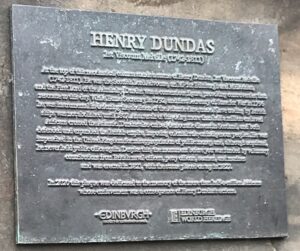
The inscription on the monument now reads:
“Henry Dundas, 1st Viscount Melville, 1742-1811.
At the top of this neoclassical column stands a statue of Henry Dundas, 1st Viscount Melville 1742-1811. He was Scottish lord advocate, an MP for Edinburgh and Midlothian, and first lord of the admiralty. Dundas was a contentious figure, provoking controversies that resonate to this day. While home secretary in 1792, and first secretary of state for war in 1796 he was instrumental in deferring the abolition of the Atlantic slave trade. Slave trading by British ships was not abolished until 1807. As a result of this delay more than half a million enslaved Africans crossed the Atlantic. Dundas also curbed democratic dissent in Scotland, and both defended and expanded the British empire, imposing colonial rule on indigenous peoples. He was impeached in the United Kingdom for misappropriation of public money and although acquitted he never held public office again. Despite this the monument before you was funded by voluntary contributions from British naval officers, petty officers, seamen, and marines and was erected in 1821 with the statue placed on top in 1827.
In 2020 this plaque was dedicated to the memory of the more than half-a-million Africans whose enslavement was a consequence of Henry Dundas’s actions.”
Of course, even Dundas has his defenders (McCarthy 2022) and there are those who say his actions to weaken Wilberforce’s 1792 slavery abolition bill ensured that abolition passed ‘in principle’, creating the settled consensus that carried the later 1807 Slave Trade act to ratification. Similarly, there are many that seek to downplay the role that Hume and Smith had in shaping the more noxious views of their time. Indeed, we must make a charitable effort to understand that the academics that have remained in prominence today have only come down to us because they were prominent due to their political and social connections in their own time. It is therefore unsurprising that they repeat or at the very least conform to the norms of their historical political class. We must therefore seek to have our conversations based on what they actually did and not resort to labels that though correct, can be easily undermined if no persistant effort is put into substantiating them.
Thomas Muir (1765 – 1799)
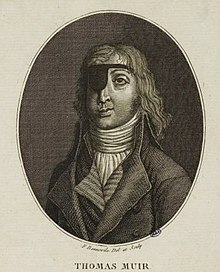
Photo: Musée de la Révolution française.
Thomas Muir is associated with the University of Edinburgh by studying here as a student. He was a political reformer and later republican at the time of the French Revolution. He allied Republican rights-based government with a Scottish Presbyterian moral framework which has come to dominate the modern Scottish Nationalist tradition.
Thomas Muir was born in Glasgow in 1765. As a result of being the son of a minor laird he was able to buy property and acquired his better-known title, Thomas Muir of Huntershill. By the time of his death Muir would instead have a different epithet “the father of Scottish democracy”. Muir was educated within the Kirk and studied divinity at the University of Glasgow. He had hoped to use this experience to join the “auld Lichts” the conservative faction of the Scottish Kirk. However, following a disagreement with the faculty of the University of Glasgow over the publishing of “A Statement of Fact”, an article on the teaching conditions within the University, Muir was expelled. Muir found refuge within the University of Edinburgh studying law under Whig Professor John Wylde. Here he became embroiled in Kirk politics to defend the autonomy Presbytery (religious body) against the encroachment landed aristocracy that attempted to reserve the right to appoint preachers on land they owned – known as the “parchment barons” dispute. With his newfound notoriety in advocating for reform and following the revolution in France Muir joined the Friends of the People society in London. Soon after Muir set up the Scottish Friends of People Society in Scotland advocating for parliamentary reform. Muir’s approach was novel in that it acted to raise social consciousness across southern Scotland in much the way as a religious movement (this sort of campaigning bears similarities to earlier covenanter mobilization). As argued by Tom Devine (2015), Muir would ride the wave of radical religious reformation in Scotland and orient this towards reformation of the political system. By attacking the second of these Muir would ultimately be disfigured and imprisoned.
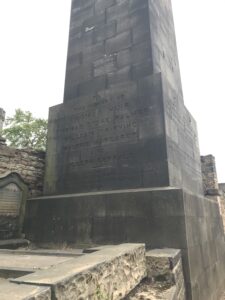
Muir would come to be influenced by Republican politics through Thomas Paine’s the rights of man. He would also begin the process we see today of a deliberate separation of the “periphery” of the British state from the English “center” by reinforcing ties with the United Irishmen, predominantly non-church of Ireland republicans, while pushing away the United Englishmen that he saw as not radical enough. Muir even came to oppose the Act of Union. As a result, he has been adopted by many, including Alex Salmond, as the starting point of left-wing nationalism in Scotland. Unlike the United Englishmen the authorities would clamp down hard on the suspected Jacobins in Ireland and Scotland. Following a summary trial for sedition Muir was transported to Botany Bay Australia. The same day as Muir’s trial, Robert Burns began the writing of the ballad “Scots Wha Hae” and made clear in correspondence that his references to Wallace as a harbinger of freedom and liberty were an allegory of Muir’s struggle [5]. Muir would later escape to the Americas. In an attempt to return to Europe Muir would lose an eye and the disfigurement of his face from shrapnel shot by the Royal Navy while a prisoner on a Spanish ship. Despite this Muir would arrive in Jacobin France being held up as “martyr of liberty”. During this period, he associated heavily with Thomas Paine the writer of the Rights of Man, for the distribution of which caused Muir too be first charged with sedition, and James Napper Tandy a leader of the united Irishmen. In response to the unrest in Scotland during the passing of the Militia act, that acted as a form of home guard conscription bill, Muir appealed to the French Directory for military intervention in Scotland. Unfortunately for Muir when the French’s Irish expedition failed in 1798 there was no longer much support for a Scottish entanglement. Muir would die as “Citoyen Muir” in France and shortly before his death wrote that “We have achieved a great duty in these critical times. After the destruction of so many years, we have been the first to revive the spirit of our country and give it a National Existence.”

Muir was a prolific writer on both the intricacies of applying a republican government in Scotland but also the legal status of slavery and religion. His most important text is possibly his speech from the dock following a highly publicized trial for sedition. His writings are relevant today as the father of the Scottish radical tradition and one of the principal architects of the political Celtic-rUK fault lines we see in the UK today. Beyond this Muir contributed heavily from a technical standpoint to the Republican tradition and its application in Scotland, and gave significant thought to the interplay of Presbyterian religious practices and the republican state. He would be a good inclusion as a contrast to Mary Wollstonecraft and Burke, him being a republican who took action as a result of the French revolution, producing some remarkably radical documents. Muir was remembered within the radical tradition in Scotland and commemorated on the Carlton Hill obelisk seen below.
The Scottish Political Martyrs Obelisk Old Calton Burial Ground on Calton Hill, Edinburgh
27-meter-tall monument erected by radical MP and Edinburgh graduate Joseph Hume that would come to pass the 1832 reform act. The inscription reads:
“To the memory of Thomas Muir, Thomas Fysh Palmer, William Skirving, Marice Marcrarot, and Joseph Gerrald. Erected by the friends of parliamentary reform in England and Scotland 1844.
‘I have devoted myself to the cause of the people – it shall ultimately prevail – it shall finally triumph’ . Speech of Thomas muir in the court of Justiciary on the 30th august 1793
‘I know that what has been done these two days will be rejudged’. Speech of William Skirving in the court of the justiciary on the 7th of January 1794.”
Selected works by thinker
‘England’s Foreign Trade’ – Thomas Muir (Pre-1784): This paper is for the moment lost but would be good to see Muir’s views on imperialism while he was still in the conservative faction of the Scottish Kirk.
A Statement of Fact – Thomas Muir (1784): Against the faculty of Glasgow university relevant for student protests and strike work in university today.
Thomas Muir of Huntershill: Essays for the Twenty First Century ISBN: 1846220513 (1780-1799): Collected works of Thomas Muir includes his speech from the dock that was his most publicized document. (See also the lecture by Glasgow university bellow on Muir’s legal texts on slavery that are not included).
Thomas Muir a speech on the dock (August 1793): most widely recognized and influential speech where he lays out a justification for his actions and the principles of democratic reform in Scotland. This can be found in the above document.
Interesting sources on the thinker
‘Auchnarin’: biography of Thomas Muir and analysis, insightful analysis into muirs relevance as a thinker http://www.auchinairn.co.uk/
‘The Faculty of Advocates: Thomas Muir of Huntershill’: Edinburgh university document about muir https://www.advocates.org.uk/faculty-of-advocates/history-of-faculty/thomas-muir-of-huntershill
‘Thomas Muir’ song by Dick Gaughan: Folk Song https://www.youtube.com/watch?v=jeXew47nCPU
Edinburgh University ‘Thomas Muir event’ – lecture by Tom devine: Very good lecture about placing Muir and the Scottish political system in context. Interesting discussion of Muir’s relevance as a thinker today and the role Muir played in the first religious reformation then political reformation. https://www.youtube.com/watch?v=GaD5mEVBw4U
‘Thomas Muir of Huntershill On Slavery: A Rediscovered Legal Thesis’: Interesting lecture by the University of Glasgow. Here they analyse Muir’s participation in the emancipation struggle in the United Kingdom and the British Empire through his position as an advocate. https://www.youtube.com/watch?v=3ln_-_FGHkg&t=478s
‘Scottish review on Thomas Muir’: Biography and analysis https://www.scottishreview.net//AndrewHook150a.html
McBride, Ian. ‘Scripture Politics: Ulster Presbyterianism and Irish Radicalism in the late Eighteenth Century Scripture Politics: Ulster Presbyterianism and Irish Radicalism in the late Eighteenth Century. ‘ (1998): Analysis of Muir’s views on religion and his impact on republicanism and the democratic struggle in the British isles in his republicanism
‘Thomas Muir of Huntershill on slavery’: Literature surrounding lecture talked about above. http://cscs.academicblogs.co.uk/thomas-muir-of-huntershill-on-slavery-a-rediscovered-legal-thesis-by-professor-gerrard-carruthers/
Marion Kirkland Reid (1815 – 1902)
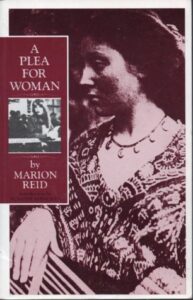
Photo: A plea for woman via Good Reads
Marion Kirkland Reid was an early Scottish feminist. She developed ideas of rights-based feminism following the same framework as Mary Wollstonecraft. Reid wrote, lived, and developed her ideas while in Edinburgh and was published within the Edinburgh University associated journal, the Edinburgh Review.
Marion Kirkland Reid was born in Glasgow in 1815. Though not much is known about her early childhood, however, Reid was given a very high standard of education despite not being able to be admitted to university in Scotland. Through her husband Hugo Reid, a progressive Edinburgh educator, Reid was able to continue her talent for writing. We know that Reid became somewhat influential in women’s movements on the abolition of slavery being the only Scots woman to attend the London 1840 convention. She was also influential in the Ladies National Association for the Repeal of the Contagious Diseases Acts which aimed to remove legislation that had legalized prostitution with a registered health certificate but that did not provide protections for women’s safety. This activism would come to inform her positions in her later writings.
Reid would anonymously write for the influential Edinburgh Review about woman’s suffrage under the pen name “a woman” in an article named Woman’s Rights and Duties Considered with Relation to their Influence on Society and on her Own Condition. In this article Reid wrote a critique of women’s suffrage and their position in Scottish society. However, though outspoken in relation to other Scottish female authors, many of the motifs were similar to Wollstonecraft’s earlier a vindication of the rights of women. Following the success of this article Reid was approached by publicist William Tate to write a published book Woman, her Education and influence. This would also become known as A Plea for Woman. In this she would expand upon the earlier writings and analyse the French revolution and its failure to accommodate woman (going beyond the work of Wollstonecraft) as well as a more in depth look into the right to vote as a tool for emancipation.
Reid did much to accustom Scottish society, that had been incredibly patriarchal, to the idea of a female writer and came to prominence with women’s feminist circles in Edinburgh. However, due to her family, Reid emigrated to Halifax for a period lost touch with the movement. Her works instead became widely published in America and Feminist writer Susanne Ferguson(1988) later pointed out that her book was “the first to be written by a woman, for women, specifically arguing that the possession of the vote is crucial in ending discrimination”.
Selected works by thinker
‘Woman’s Rights and Duties Considered with Relation to their Influence on Society and on her Own Condition’ The Edinburgh Review (1841): An essay that can be found at national libraries of Scotland. Written under pen name a woman. This is the first recorded writing by Marion Reid. In this she reiterates many of the points already put forward by Mary Wollstonecraft, however, this has been applied to a lower-middle to middle class “Scottish” setting and as such goes beyond the more elite level that Wollstonecraft conducts her analysis. It is interesting to read more about Reid in contrast to other female writers (that are featured along Reid in a special women’s section of this edition of the Edinburgh review). Of these Reid is the most outspoken while the others are more moderate thinkers. It is interesting to note that these moderate writers did not use a pen name and had titles associated with their names. Reid being an educator/spouse of an educator was most definatley not from the same milieu. This class dynamic should be explored further.
Edinburgh review digitized version: https://www.proquest.com/docview/6528043/BA9334906A9E4246PQ/7?accountid=10673&imgSeq=1
‘Plea for woman'(1843-onwards): subsequent book giving a deeper insight into Reid’s feminist philosophy and shows her developing her own positions independently from preceding feminist structures – ie Wollstoncraft. Her main point throughout the book is that the vote is the most important emancipatory tool.
Interesting sources on the thinker
Unfortunatley there are no reputable works that directly focus on Reid. This is a shame. However, here are some works that mention Reid in some capacity:
Crawford, Robert (2007). Scotland’s books : the Penguin history of Scottish literature: Crawford is better than most and gives insights into the writing history of Reid and her activism. Little said about evaluation of her work.
The biographical dictionary of Scottish women: from the earliest times to 2004. Ewan, Elizabeth., Innes, Sue., Reynolds, Sian. Edinburgh: Edinburgh University: A lot more given as evaluation particularly in reference to other leading Scottish female writers.
A biography of Reid: some analysis by an obscure source; due to the dearth of sources this is well worth a read but not completely illuminating. It seems that there is room for more writing to be done about reid in the same vein as this article here. https://web.archive.org/web/20120224025255/http://www.pinn.net/~sunshine/whm2003/reid.html
McFadden “Golden Cables of Sympathy: The Transatlantic Sources of Nineteenth Century Feminism states”: Talks about the American understanding of Reid and how hard it is to study her due to the lack of sources: diaries and biographies ect. Which leads many to project onto her their own opinions.
James Connolly (1864 – 1916)
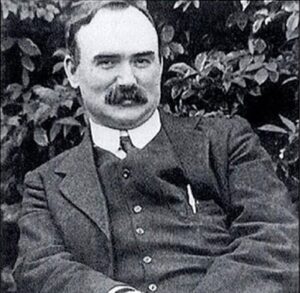
Photo: National Census of Ireland Exhibition
James Connolly was a forged by the Edinburgh working-class. He was a socialist leader and a leading thinker of the 1916 Irish Easter Rising, after which he was executed by the British state. His main contribution to republican tradition was synthesizing a unity between Christianity, Socialism and Celtic Nationalism that still reverberates in British and Irish politics today.
James Connolly was born in the Edinburgh Cowgate Slums known as “little Ireland” and left his Catholic school before the age of 11. He joined the British army at 14 and served in Ireland for four years suppressing agricultural revolts. It was from this experience of repression that Connolly grew to hate the army as an institution; when his regiment was re-assigned to service in India he deserted. After his desertion Connolly would stay in Edinburgh and became active in Socialist politics. It was in Edinburgh, Connolly became exposed to readings of Marx and Engels, and would base his late analysis on this teaching. Connolly rose through the Edinburgh Socialist ranks eventually becoming the secretary of the Scottish Socialist Federation. He held this position for over 5 years, associating with Keir Hardie’s Independent Labour Party and the campaign for the 8-hour workday. It was in this period that Connolly began his connection with Irish nationalism. In his letters on “the language movement” he attempted to encourage the Irish nationalists involved in the Gaelic language revival to consider also learning Esperanto as an international language of socialists. After this intervention, Connolly was asked to be permanent secretary of the Dublin Socialist Club where he would come to do most of his political work.
Connolly made important contributions to the use of Marxist analysis in international relations, where he produced an early iteration of systems theory. He also made valuable contributions to Republican thought through his texts on a positive definition of liberty being necessary for a functioning state. His insight into land reform within the British empire is interesting because of his first-hand knowledge about the use of force in the implementation of agricultural policy but also his comparative analysis of land reform across different European states. Connolly showed an interest in socialist revolution as part of the agrarian and industrial societies and understood that both needed to happen simultaneously for a successful socialist state to take place. His memory is still an influential motif in Irish politics and much research has been done into the various aspects of his thought and particular contributions to the theory of socialist government.
Connolly became widely read in Irish American circles and was a speaker in America and a trade union organizer in New York 1906-1910. Alongside Jim Larkin he continued to agitate the working class in Dublin and following the 1913 strikes and lockout he formed the Irish Citizens Army. Connolly, like Lenin and other prominent socialists, would oppose the First World War and campaign against its prosecution. However, as the nationalist sentiment grew in Dublin, Connolly would come more involved with the Irish Republican Brotherhood (IRB) and became one of the leading figures in the 1916 Easter Rising. As one of the signatories to The Proclamation of the Republic, Connolly who had been injured during fighting at the General Post Office in Dublin would be executed by firing squad. Though he abandoned religion in his youth Connolly returned to Catholicism in the final days before his death, though he had used his religious upbringing as a moral guide throughout his life.
It is important to note that there has been a significant amount of “green-washing” in the legacy of James Connolly. Some in the South (mostly traditionally Fianna Gael supporters) see Connolly as solely a nationalist figure -disregarding Connolly’s socialism as “love for the poor”. In contrast, some in the North (typically associated to Sinn Fein) see Connolly as first a socialist then a nationalist and a model for a left-wing Irish state. Therefore, we should be wary about how much we ascribe the nationalist slogans to Connolly, who from most of his writings appears to be concerned with mediating the rising nationalist tide in early 1900s Ireland towards a socialist revolution rather than a nationalist conclusion. Unpacking this aspect of Connolly could be a valuable teaching moment especially given how the memory of Connolly has been politicized in recent years.
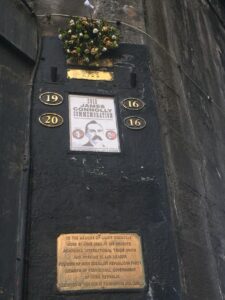
Unknown Photographer creative commons
James Conolly Plaque – under George 5th bridge, outside of Subway nightclub, Canongate Edinburgh. This plaque originally caused controversy due to Connolly’s association with Irish republicanism and the James Connolly society that was linked to support for the PIRA. Following the suspension of republican marches by the society after the Good Friday agreement, and the intervention of Sir Tom Devine the Connolly memorial was added in 2016 – 100 years after Connolly’s execution. Inscription reads:
“To the memory of James Connolly Born 5th June 1868 at 107 Cowgate Renowned International trade union and working class leader. Founder of Irish socialist republican party. Member of provisional government of Irish republic. Executed 12th May 1918 at Kilmainham gaol Dublin”
Selected works by thinker
‘Socialism and Nationalism’ (1897): Connolly lays out the need for socialism as a mediating force to nationalism and elucidates what he sees as the hierarchy of needs for republican government as first socialist and nationalist as means to an end but that nationalism of all kinds may be a mask for the maintenance of the social structure. “If you remove the English Army tomorrow and hoist the green flag over Dublin Castle., unless you set about the organization of the Socialist Republic your efforts will be in vain. England will still rule you. She would rule you through her capitalists, through her landlords, through her financiers, through the whole array of commercial and individualist institutions she has planted in this country and watered with the tears of our mothers and the blood of our martyrs.”
‘The Re-Conquest of Ireland’ (1915): Though laying out Connolly’s primary political philosophy he also delves into Marxist account of feminism which can be summarized by the phrase “The worker is the slave of capitalist society, the female worker is the slave of that slave”.
‘Peasant Proprietorship and Socialism’ (1898): Looks at land reform in Ireland and historical examples through the Marxist framework with a particularly good examination of the effects of the church system in Ireland.
‘British and Russian Imperialism I and II’ (1898): A Marxist analysis of the role of empire in the late Victorian period with specific reference to the rights and liberties of sub-state minorities. Connolly plays close attention to the difference and similarities to workers within the Russian and British systems. In this we can see the beginnings of an analysis similar the systems theory of Marxist IR.
‘Let Us Free Ireland!’ (1899): “Whoop it up for liberty – let us free Ireland”. Connolly makes clear the link between socialism and nationalism and how without socialism there can be no justice. Here Connolly advocates for positive liberty as the foundation of republican government also serves as a manifesto, similar layout as Marx’s Communist manifesto.
‘Last statement of James Connolly before execution’ (1916): https://www.marxists.org/archive/connolly/1916/05/laststat.htm
Interesting sources on the thinker
‘Whoop it up for liberty – let us free Ireland’: A reading of the Let Us Free Ireland by Sinn Fein members, intresting to note the presence of many contemporary Sinn Fein politicians and Jerry Adams that still show the claiming of Connolly by Irish Republicans. https://www.youtube.com/watch?v=7k1b_oxnif4
‘A reading of the Last statement of James Connolly’: The last statement to the court before Connolly’s execution. https://www.youtube.com/watch?v=wKROfWOCTdY&t=1s
‘James Connolly the dream’: Legacy of Connolly in music https://www.youtube.com/watch?v=SwPGUqI_ajY
‘Oh were o where is our James Connolly’: Legacy of Connolly in music https://www.youtube.com/watch?v=C9cyOgNVbaM
‘Black 47 -James Connolly’: See this piece in contrast to below. This piece made by Irish-Americans takes Connolly more as a socialist hero than a nationalist/republican one. https://www.youtube.com/watch?v=wukfdjJv340
‘Wolfe tones – James Connolly’: This group the Wolfe Tones takes part in the nationalisation/greenwashing of Connolly’s memory https://www.youtube.com/watch?v=iYH5h-5Dz40&t=120s
‘Connolly poem- Liam MacGabhann’: https://www.youtube.com/watch?v=iYH5h-5Dz40
Further works on James Connolly works preserved by Marxist.com: https://www.marxists.org/archive/connolly/index.htm
Julius Nyerere (1922 – 1999)
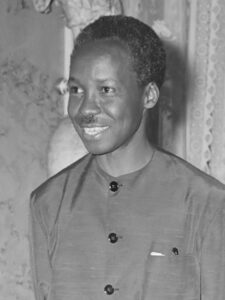
Photo: Eric Koch / Anefo Nationaal Archief
Julius Nyerere, an Edinburgh Humanities Graduate, is considered the father of modern Tanzania but also a political thinker who merged socialist ideas with African tribal structures as well as contributing to the Pan-African tradition.
Julius Nyerere was born in Butiama in present-day Tanzania. His father was a Zanaki tribal chief and as such the young Nyerere had exposure to the administration of African government. After attending a Catholic school, Nyerere attended college in Uganda before leaving to study Master of Arts at Edinburgh University, lodging in the Grange. Though not an outstanding student Nyerere would come to develop his political voice in Edinburgh writing in The Student magazine and taking part in the campaign to dissolve the white-minority protecting federation of Tanagyika. After graduating Nyerere traveled back to Tanzania and established himself within the Zanaki tribal system.
He joined the Tanganyika African association (TAA), a society much in the same vein as the ANC and was brought forward as a leader in the movement due to his primary skills on securing independence for Tanzania. Later he would join the Tanganyika African National Union (TANU) and became interested in the non-violent methods of Mahatma Gandhi. Through the early process of decolonization Nyerere’s party was able to secure 70 of the 71 seats in the 1960 general election. This propelled him to power in Tanzania and led to independence. He would come to clash with South Africa’s apartheid president Hendrik Verwoerd and would receive an honorary law degree from Edinburgh in 1962. While in power Nyerere would prosecute a war against Uganda which ultimately rid the country of Idi Amin. Nyerere would remain in power until 1985. He is still today regarded as the father of the Tanzanian nation.
The intricacy of Nyerere’s political system has been well-studied. He mixed elements of traditional tribal government he had learnt as a Zanaki tribal leader with socialist ideas he had read about at Edinburgh. The result was a fusion which that parallels John MacLean’s history of the soviet-clan system. One point that we may disagree with Nyerere is his advocacy of the one-party state that he believed resembled tribal structures. While it is true that there were avenues for advancement given to Tanzanians, these were limited to those that worked from within the system, which through its tribal roots could be hierarchical. Yet we cannot describe him as running a kleptocracy.
Nyerere offered grants for Tanzanian students to study both at Edinburgh and in universities around the world and had devoted a sizable part of his wealth to charitable endeavors. He also held good relations with the Soviet and Maoist blocs, receiving aid from both East and West while towing the fine line to maintain autonomy. He was a principle advocate of Pan-Africanism; throughout his presidency pushing to establish a East-African federation. However, like many movements of this time, the federation collapsed due to rivalries at the executive level between would-be leaders. The study of this collapse and the roles of “conceptualized history” vs executive power could be an interesting study for a more IR based Politics course.
Works by thinker
‘The Student (1951)- Julius Nyerere ‘: First involvement with pan-African politics and the colonial struggle. Begins to talk about tribal structures in Africa.
‘Ujamaa: essays on socialism’ (1968): Book by Nyerere. Links together his philosophy of socialism and pan-African government.
‘Binadamu na maendeleo’ (1974): Book by Nyerere that translates to “man and development” and is a look into his vision for Tanzania and the surrounding region. lays out of his development philosophy and touches on a theory of history.
‘Freiheit und Entwicklung’ (1974 and on wards through multiple editions): A series of his most influential articles and speeches. A reading/translation of these would be necessary for any course.
Interesting sources on the thinker
Julius Nyerere fellowship programme: Biography and analysis as well as information about his academic Grant scheme. https://web.archive.org/web/20061019131749/http://www.africasummit.org/about/nyererefellowship.html
Molony, Thomas (2014). ‘Nyerere: The Early Years’: In depth biography of Nyerere’s early life and the inspirations of his political philosophy. Beware that this does read in a very positive light and could be considered propaganda.
ANC biography of Nyerere: African national congress honors Nyerere as a leader of Pan-Africanism and hero of African emancipation from the colonial struggle. https://web.archive.org/web/20051120184754/http://www.anc.org.za/ancdocs/history/people/nyerere/newsart.html
Bjerk, Paul (2015). ‘Building a Peaceful Nation: Julius Nyerere and the Establishment of Sovereignty in Tanzania, 1960–1964.’: examines how Neyrere negotiated with the colonial administrations of southern Africa, the potential establishment of a Pan-African administration, and his influence on government in Tanzania.
Lal, Priya (2015). ‘African Socialism in Postcolonial Tanzania: Between the Village and the World.’: An analysis of Neyere’s African Tribal-socialism and from this analysis we can see the similarities with John MacLean’s soviet clan system. I would say this is the best article for understanding Neyere’s effectiveness as a socialist leader.
Žák, Tomáš František (2016). ‘Applying the Weapon of Theory: Comparing the Philosophy of Julius Kambarage Nyerere and Kwame Nkrumah’: Analyses the Neyerere’s political philosophy and the righteousness of the one-party policy.
The Nyerere scholarships at Edinburgh university: Facebook of the organisation running the Tanzanian grant system for the university of Edinburgh. https://m.facebook.com/media/set/?set=a.223406707672522&type=3
Best practice from other departments and courses
As part of this project a short survey of how other programs, both within and out with Edinburgh, handle situating their chosen course content locally. Similar programs in University of Oxford do highlight local alumni; interestingly within Edinburgh, online courses are more progressive in this sense than our traditional format ones.
Instead of focusing on past Edinburgh thinkers the philosophy course “Knowledge and Reality” tried to as best as possible incorporate the work of current academics from within its own department. This is useful as it overcome the gap of knowledge that many academics have when it comes to teaching Edinburgh’s historical figures. Thus, making it easier for the politics department to include Edinburgh Associated thinkers. Here the course focuses on Mazviita Chirimuuta’s Philosophy of Colour (2015) or Aidan McGlynn’s Knowledge First epistemology (2014). These also help to fulfill the “world leading research continues to take place here” part of the equation, that was set out in the introduction, for students to feel that they are continuing in a tradition of excellence within the University. Similarly, within Political Science at Oxford students still study Isaiah Berlin the Russian-British social theorist and Oxbridge graduate. There is also an emphasis on G.A.Cohen the Marxist historian who also studied at Oxford. These are not current academics but are close enough that they still have some meaning to lecturers or were prominent when lecturers were themselves undergraduates – making them easier to study than long deceased historical thinkers. Further work on this front at Edinburgh would be best carried out by those currently in the department.
Ironically Edinburgh’s online provision headlines more local academics than the in-person courses. The University runs a Massive Open Online Courses (MOOCs) through Coursera, which is open for anyone to sign up for free. One course, by Dr David Ward, an “Introduction to Philosophy”(2015), approaches Edinburgh thinkers well. Using online media Dr Ward visits the locations of some of the more celebrated Edinburgh-based philosophers. Thereby he creates a connection between Edinburgh, the city, and Edinburgh, the University. Obviously, this is as much an advertising segment as a university course, but the MOOC was very innovative in using videos of locations to give a spatial experience of Edinburgh for those that cannot experience it in person. While looking at this course I did wonder how tools like this could have been useful in lock-down to make the connection between the student and the University more tangible, at a time in which our experience of Edinburgh was decidedly fractured. Of course, it is hard to ask professors to go on location to make videos but there could be teaching given at different locations round the city as most of these are pretty central. The University even offers MOOCs on how to make MOOCs and on location videos. An interested lecturer could explore this further there.
The school of Literatures, Languages and Cultures (2018) does well in including local thinkers. They have been compiling a list of Black, Abolitionist figures who have been associated with Edinburgh and more widely Scotland. They have created an in-depth map system that shows various locations round the city associated with black emancipation. One space featured is the Lidl on Nicholson Street – often visited by students and the location of emancipation gatherings and speeches. They show both the map of the area and a little blurb of the significance of the spot. In the School of Politics and Social Science, we could produce a walking route between suitable markers as a way to get interested students to make connections between their course material and its relevance to the local Edinburgh environment increasing the Student-City connection.
The National Libraries of Scotland (Leabharlann Nàiseanta na h-Alba 2018) has also produced a great amount of resources about decolonizing Scottish history and recognizing marginalized groups. One such example has been their exhibition on Fredrick Douglass (which I recommend for all to visit their web-page and, eventually when the exhibition returns, to go visit the exhibits dedicated to Douglass in Edinburgh Museum).
Finally, the University used to run a housing scheme The Edinburgh Settlement starting in the early 1900s whereby first year students would be housed amongst working-class households across Edinburgh’s Cowgate and Dumbiedykes (Ragged University 2018). The idea behind this was to create a link between the local community and student population such that students could develop their understanding of social class and to allow an influx of knowledgeable students to help in the education of the local community. The usefulness of this later aim is most likely no longer applicable. While the settlement went bankrupt in 2011, there is merit to the University authorities increasing the interface between the city of Edinburgh and its student population and this could serve as link to try dispelling the view that Edinburgh University is the University of Edinburgh more than merely being a University in Edinburgh.
Conclusion
In this project I hope that I have been able to put forward a case for the inclusion of Edinburgh-associated thinkers within the politics undergraduate curriculum. There are a wealth of thinkers associated with Edinburgh university, and I hope that some of the few I have chosen to introduce would be useful. There are interesting contrasts between the works of Thomas Muir, and our current respected thinkers in Hume and Smith. There is also commonalty in the works of Nyerere, MacLean and Connolly through their conception of socialism to tribal/clan based political structures that should be studied further. Lastly, we have identified Marion Kirkland Reid’s feminism as a critically understudied text that should be developed further and this can be done by encouraging its inclusion in the teaching curriculum. Over the course of this project, I found that potentially studying the work of current Edinburgh academics is more useful as it creates the same institutional cohesion but also overcomes the knowledge gap associated with studying past obscure authors. Anyone looking to continue in the aims of this project should consider if any current work is being done in the department that could be applicable to first- and second-year Politics students.
Notes
All images without captions of a copyright holder have been taken by the author or are directly subject to creative commons.
[1] At the time that I studied them (2020-2022).
[2] For example, “Greats: From Plato to the Enlightenment (PHIL08016)” or “Knowledge and Reality (PHIL08017)”.
[3] The concours for Scottish students at these universities can be more intense than at Oxbridge. One data point would be that in my course PPE the Scots acceptance rate was 11% in the same year at Oxbridge was 13%. This leads Scots to either pay to go abroad or agglomerating in institutions that cater to nearly exclusively Scottish students and that therefore run on lower budgets (under £2,000 per student).
[4] By including differing cultural perspectives and studying a range of thinkers. This can be achieved by having a range of staff from differing University backgrounds. However it would also be undesirable to have a homogeneous student population – this would severely limit the quality of thought, the application of ideas, and the student experience of the University. Instead, my grievance is with the current conception of internationalisation and the idea that internationalisation would be compromised by studying anything resembling the national or local.
[5] This tells us more about Burns than Muir who often has a tension in being the author of works like “a man’s a man” and “tae a moose” but also conforming to a largley conservative-whig audience.
Contact
liampmclaughlin@gmail.com
Liam McLaughlin – 2nd year student of MA (Hons) Politics, Philosophy and Economics at the University of Edinburgh – winner of the James Hutcheson Stirling Philosophy prize, Simon Gray Philosophy prize, and Simon Gray Politics prize.
Bibliography
Chirimuuta, M. (2015) Outside Color: Perceptual Science and the Puzzle of Color in Philosophy. Cambridge, MA : MIT Press.
Davie, G. E. (1961) The Democratic Intellect: Scotland and her Universities in the Nineteenth Century. Edinburgh: Edinburgh University press.
Devine, T. (2015) ‘Thomas Muir Lecture’, Thomas Muir Anniversary Event, 25th August, First Division courtroom, Parliament House, Edinburgh.
Ferguson, S. in Reid, M. K. (1988) A plea for woman. Edinburgh: Polygon.
In Our Time. (2015) ‘The Wealth of Nations’ Available at: https://www.youtube.com/watch?v=pTVOmCmh504.
Immerwahr, J. (1992) ‘Hume’s Revised Racism’, Journal of the History of Ideas, Vol. 53, No. 3, pp. 481-486.
McCarthy, A. (2022) ‘Historians, Activists and Britain’s Slave Trade Abolition Debate: The Henry Dundas Plaque Debacle‘, Scottish Affairs, Vol 31. No 3. pp 325-344.
McGlynn, A. (2014) Knowledge First?. London: Palgrave Mcmillian.
McLaughlin, M (2022). ‘No places at Edinburgh University law course for top students’, Times, Available at: https://www.thetimes.co.uk/article/no-places-at-edinburgh-university-law-course-for-top-students-tlqssqqwm.
National Libraries of Scotland. (2018) ‘Strike for Freedom: Slavery, Civil War and the Frederick Douglass family’, Available at: https://www.nls.uk/exhibitions/frederick-douglass/.
Ord, H. for the Adam Smith Institute (2021) ‘In support of Adam Smith’s Legact against slavery’. Available at: https://www.adamsmith.org/blog/in-support-of-adam-smiths-legacy-against-slavery.
Popkin, R. (1977) ‘Hume’s Racism’, Philosophical Forum, Vol. 9, No. 2, pp 211-226.
Ragged University. (2018) ‘Edinburgh Settlement’, Available at: https://raggeduniversity.co.uk/edinburgh-settlement/.
School of Literatures, Languages and Cultures. (2018) ‘Our Bondage and Our Freedom: Frederick Douglass & Family ~ Their Struggles for Liberty 1818-2018’, Available at: https://ourbondageourfreedom.llc.ed.ac.uk/maps/.
Scottish Legal Times (2022) ‘Edinburgh Law School rejects straight-A students’, Available at: https://www.scottishlegal.com/articles/edinburgh-law-school-rejects-straight-a-students.
Smith, A. Meek, R. L. (1763) Lectures on Jurisprudence: Report of 1762-3. Edinburgh: Edinburgh university press. Available at: https://oa.mg/work/10.1093/oseo/instance.00042877.
Ward, D. (2015)’Introduction to Philosophy by the University of Edinburgh’, Available at://www.coursera.org/learn/philosophy.
Weinstein, J. R. for Adam Smith Works (2017) ‘Adam Smith on Slavery’. Available at: https://www.adamsmithworks.org/documents/adam-smith-on-slavery/.




Recent comments